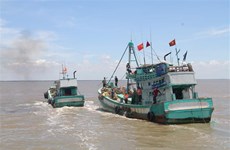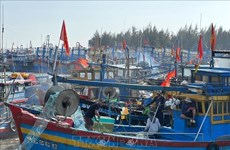AO victim determined to lead useful life
She cannot walk very well after being exposed to Agent Orange/dioxin but
she wears a perfect smile when talking about her life.
She cannot walk very well after being exposed to Agent Orange/dioxin but
she wears a perfect smile when talking about her life.
Nguyen Thi Ha, from the port city of Hai Phong, was physically deformed from birth in 1980 because her father was contaminated with the toxic chemical Agent Orange on a southern battlefield during the American war.
Despite her restricted mobility, Ha says she has always been determined to work for a living and fully integrate into the community so she chose hairdressing as a way of making her living.
She remembers that when she started to learn her hairdressing skills from a professional hairdresser in 2000 that the work posed a huge challenge to her because of her lack of mobility.
However, she proved to be brave as her father had been on the battlefield and that her strong determination and hard work could help her to succeed in the job and she eventually made it.
She is now a well-known hairdresser. She has passed on her skills free-of-charge to at least 50 other disabled people to enable them to support themselves financially.
Ha recalled her story to the participants of a forum held in Hanoi recently for AO victims where they discussed how they had overcome the pain and agony caused by the defoliant with the help of the State’s supportive programmes, including one that focuses on rehabilitation and job training.
In 1987, the Health Ministry launched a similar programme across the country, for up to 4.8 million people who had been exposed to AO, including 3 million victims who are still suffering from the affects of the deadly chemical.
First carried out in the Mekong delta province of Tien Giang, the programme was expanded to 51 cities and provinces nationwide by the end of 2009.
It has provided job training and placements to 27 percent of AO victims and community-based supportive services to 71 percent of both AO victims and disabled people.
Currently, three rehabilitation centres for the victims of toxic chemicals are operating in the Red River Delta province of Thai Binh, the central province of Quang Ngai and the southeastern province of Dong Nai .
These centres have helped to improve the quality of the victims’ lives by helping them integrate into the community after receiving rehabilitation and knowledge on the field.
A further 10 more centres are expected to be built for AO victims in the near future.
Like Ha, many AO victims have spared no effort in overcoming their difficulties and have proved that they can earn a living themselves and leading a life that useful to society./.
Nguyen Thi Ha, from the port city of Hai Phong, was physically deformed from birth in 1980 because her father was contaminated with the toxic chemical Agent Orange on a southern battlefield during the American war.
Despite her restricted mobility, Ha says she has always been determined to work for a living and fully integrate into the community so she chose hairdressing as a way of making her living.
She remembers that when she started to learn her hairdressing skills from a professional hairdresser in 2000 that the work posed a huge challenge to her because of her lack of mobility.
However, she proved to be brave as her father had been on the battlefield and that her strong determination and hard work could help her to succeed in the job and she eventually made it.
She is now a well-known hairdresser. She has passed on her skills free-of-charge to at least 50 other disabled people to enable them to support themselves financially.
Ha recalled her story to the participants of a forum held in Hanoi recently for AO victims where they discussed how they had overcome the pain and agony caused by the defoliant with the help of the State’s supportive programmes, including one that focuses on rehabilitation and job training.
In 1987, the Health Ministry launched a similar programme across the country, for up to 4.8 million people who had been exposed to AO, including 3 million victims who are still suffering from the affects of the deadly chemical.
First carried out in the Mekong delta province of Tien Giang, the programme was expanded to 51 cities and provinces nationwide by the end of 2009.
It has provided job training and placements to 27 percent of AO victims and community-based supportive services to 71 percent of both AO victims and disabled people.
Currently, three rehabilitation centres for the victims of toxic chemicals are operating in the Red River Delta province of Thai Binh, the central province of Quang Ngai and the southeastern province of Dong Nai .
These centres have helped to improve the quality of the victims’ lives by helping them integrate into the community after receiving rehabilitation and knowledge on the field.
A further 10 more centres are expected to be built for AO victims in the near future.
Like Ha, many AO victims have spared no effort in overcoming their difficulties and have proved that they can earn a living themselves and leading a life that useful to society./.













